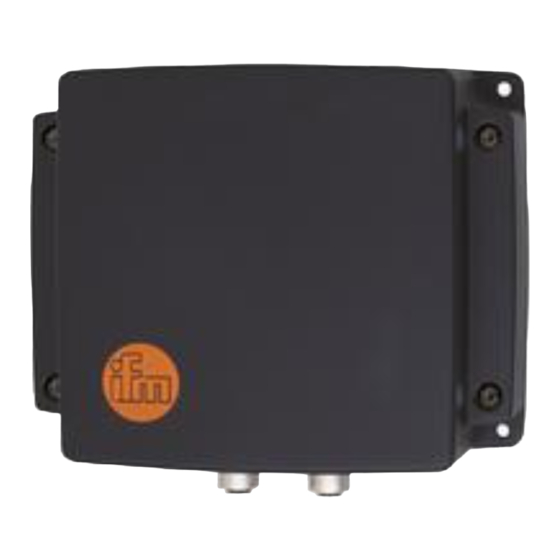Table of Contents
Advertisement
Quick Links
Advertisement
Table of Contents

Subscribe to Our Youtube Channel
Summary of Contents for IFM Electronic efector 190 DTE820
- Page 1 Operating instructions RFID UHF Sensor Mid Range DTE820...
-
Page 2: Table Of Contents
RFID UHF Sensor Content 1 Preliminary note � � � � � � � � � � � � � � � � � � � � � � � � � � � � � � � � � � � � � � � � � � � � � � � � � 3 1�1 Symbols used�... -
Page 3: Preliminary Note
RFID UHF Sensor 1 Preliminary note This document is intended for specialists� These specialists are people who are qualified by their appropriate training and their experience to see risks and to avoid possible hazards that may be caused during operation or maintenance of the device�... -
Page 4: 2�3 Electrical Connection
The device complies with the requirements to CE� Brand name: ifm electronic DTE820 RFID-UHF sensor for Europe The DTE820 is designed for operation in accordance with EN 302208� During operation the human exposure regulations to EN50364 have to be observed�... -
Page 5: Functions And Features
RFID UHF Sensor 3 Functions and features The DTE820 RFID UHF sensor integrates a mid-range RFID UHF antenna and an RFID UHF reader to process the antenna signals� The device is suited for reading and writing active and passive RFID tags in the frequency range of 865 - 868 MHz� The DTE820 has a PoE Ethernet interface and a serial interface�... -
Page 6: Characteristics Of The Antenna
RFID UHF Sensor 6 Characteristics of the antenna The RFID UHF antenna integrated in the DTE820 is a mid-range antenna which meets the requirements of many RFID applications� Mid-range antennas have been developed for applications in the near and far field�... -
Page 7: Reading Range And Selectivity
RFID UHF Sensor 7 Reading range and selectivity The reading range and the selectivity are the most important features of an RFID application� The reading range describes the greatest distance at which a tag can be read� The selectivity indicates the required minimum distance for clear distinction between two adjacent tags�... -
Page 8: Conformity With Standards
RFID UHF Sensor 8 Conformity with standards Since the RFID systems are radio systems, they are in the scope of the 1999/5/EC guideline of the European Commission (Radio and Telecommunications Terminal Equipment R&TTE)� As evidence of the conformity with the basic requirements of this guideline there is a number of harmonised standards that are published in the Official Journal of the European Union�... - Page 9 RFID UHF Sensor Max� input power Distance person 1 cm < distance 7 cm < distance and DTE820 < person and person and 1 cm DTE820 < 7 cm DTE820 General public Limit values head and trunk 2 W/kg Pin = 0�32 W Pin = 1�84 W Limit values local limbs 4 W/kg Occupational exposure...
-
Page 10: Installation
RFID UHF Sensor 9 Installation 9.1 Installation location The operating principle of the antenna is influenced by the type of installation and the environment� Observe the following remarks for the selection of the installation location: ● Keep a distance of min� 70 cm to metal surfaces and the ground (see Figure 1)� ●... -
Page 11: 9�2 Laying Of Cables
RFID UHF Sensor 9.2 Laying of cables Observe the following notes when laying the cables: ● Lay the cables vertically and straight away from the sensor (see figure on the right)� ● Avoid cable loops around and on the sensor (see figure on the left)� Figure: Incorrectly laid cable Figure: Correctly laid cable 9.3 Drilling template... -
Page 12: 9�4 Connections And Status Indication
RFID UHF Sensor 9.4 Connections and status indication The DTE820 is controlled and evaluated via two connections and a status indication� The following sections describe the connections and the status indication� 1 GPIO and RS-232 connection, M12 female, 12 poles 2 Status indication, 2-colour LED (red, green) 3 Ethernet and current supply connection, M12 female, 4 poles, D-coded Load digital inputs and outputs with max�... -
Page 13: 9�5 Gpio And Rs-232 Connection
RFID UHF Sensor 9.5 GPIO and RS-232 connection The 12-pole M12 socket of the DTE820 provides the digital inputs and outputs (GPIO) and the serial interface� Connection GPIO - OUT3 GPIO - GND RS-232 - GND RS-232 - RxD RS-232 - TxD 24 V DC 7 6 5 GPIO - OUT2... -
Page 14: 9�6 Ethernet And Current Supply Connection
RFID UHF Sensor The digital outputs are not electrically isolated from the operating voltage of the DTE820� +U B +U B OUTPUT 1 OUTPUT 1 OUTPUT 2 OUTPUT 2 OUTPUT 3 OUTPUT 3 Non-electrically isolated circuit of the outputs 9.6 Ethernet and current supply connection The DTE820 is connected to the Ethernet via the 4-pole M12 socket (D-coded) and supplied with current�... -
Page 15: Typical Applications
RFID UHF Sensor 10 Typical applications 10.1 Access systems Due to the large reading area of UHF antennas applications for access systems had been implemented via HF RFID so far� The new UHF RFID devices from ifm now allow these applications as well� For access systems such as ski lifts, buses and trains the DTE820 with integrated mid-range antenna is recommended�... -
Page 16: Abbreviations
RFID UHF Sensor 11 Abbreviations Abbreviations used in the brief instructions: European standard Effective Radiated Power RFID Radio Frequency Identification Specific Absorption Rate Ultra High Frequency 12 Maintenance, repair and disposal The device does not contain any components that need to be maintained� ►...













Need help?
Do you have a question about the efector 190 DTE820 and is the answer not in the manual?
Questions and answers